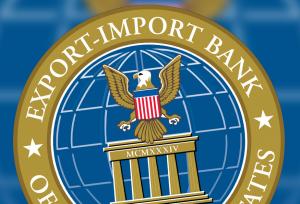Energy Firms Up-In-Arms Over Congressional Treatment of Ex-Im Bank

Over the Fourth of July, American’s celebrated the birth of a nation. But in some corners, they mourned the potential death of a federal agency that has meant a lot to energy companies, especially those in the nuclear and renewable fields: the Export-Import Bank.
Actually, on June 30th, the deadlined passed for the U.S. Congress to reauthorize the agency, which makes loans to domestic businesses — both big and small — so that they can sell their wares around the globe. While the bank is now unable to make to any new loans, it still must service the existing ones it has.
And Congress, meantime, will revisit the issue in the coming weeks: The pro-business Republicans want to see the bank’s charter live on while the Tea Party wants the bank to die, noting that it is “subsidizing” large American corporations at the expense of others that do not receive such federal help.
In truth, the Ex-Im Bank, as it is known, raked in $7 billion in revenues over two decades — and didn’t cost American taxpayers a thing, says its supporters. What irks its critics, say those same advocates, is that the bank has committed itself to lending more money to green enterprises — possibly at the expense of businesses dealing in fossil fuels.
While the bank’s most recent charter says that it must consider the environmental impacts of its decisions, it continues to heavily support oil-and-gas industry projects. That adds to national wealth and creates jobs — just as it has done for those limited number of renewable deals in which the bank has invested.
Enter politics: At the start of the Obama presidency in 2009, the Democratic Congress had changed the bank’s doctrine to say that 10 percent of its financing must head to renewable projects. In some corners, renewables has become a dirty word, or synonymous with government waste and subsidies.
While the bank is authorized to support green energy, only a tiny sliver of its portfolio is invested in those deals, or $257 million of the $37 billion total that it loaned in 2013. The money goes to a wide range of projects, diversifying its investments and spreading the potential risks, and rewards.
But there is no doubt that money flows to the oil companies at much greater levels. To that end, the Ex-Im Bank has provided nearly $15 billion since 2001 in financial assistance to just oil and gas exploration, says Nicolas Loris, a scholar with the conservative Heritage Foundation. By comparison, he says that the bank supported $1.77 billion in renewable energy projects between 2009 and 2013.
In recent testimony before Congress, Fred Hoschberg, who is chairman of the Ex-Im Bank, said that both large and small businesses benefit from the bank’s involvement — businesses ranging from General Electric and Caterpillar to the family-owned Howe Corp. and Auburn Leather. In fact, he says that 3,413 smaller enterprises are beneficiaries of the institution’s involvement.
“There is a strong drive to increase exports from many countries around the globe,” says Hochberg. “We need to send the same signal to competitor nations that we stand behind American workers and exporters and ensure that products stamped ‘made in the U.S.A.’ are able to compete on a level playing field.”
The current Ex-Im funding war is really Part II. Part I happened just before September 30, 2014 when the bank got a short reprieve to June 30, 2014. While the bank is now being used as a political weapon, it has historically been a valuable economic development tool. Just ask the nuclear sector.
Like it or not, nuclear facilities are getting built around the world. And the bidders are global, ranging from suppliers in the United States to those in Canada, France and Russia and South Korea, all of which have government-backed credit agencies that ensure project financing.
Altogether, the nuclear energy industry says that 72 such facilities are getting erected worldwide, with 173 more in the licensing phase — a $740 billion market over the next decade. The goal is to capture a share of that pie, which can be facilitated through the Ex-Im Bank. That’s because large infrastructure projects have long construction periods before they begin to generate revenue, which makes private lenders hesitant.
Meantime, many nuclear energy opportunities are in developing countries that do not provide financing for multinational corporations: China, India and the Czech Republic. Other nations vying for that business have such public-backing.
Consider Barakah One Co. of the United Arab Emirates, which will buy U.S. nuclear equipment and construction services, mostly from Toshiba Corp.’s Westinghouse: The Ex-Im Bank is providing a $2 billion direct loan, which will create 5,000 jobs in 17 U.S. states, says former U.S. Trade Representative Ron Kirk, in an interview with this reporter just before he stepped down.
“As the developing world begins to build their economies, they need the opportunity to do this in an environmentally responsible way,” adds Kirk, also a former mayor of Dallas and a co-chair for CASEnergy Coalition, a nuclear-backed group. “Many of those countries will look to us for best available technologies. Many will look to nuclear technologies, which is one of the best sources of non-carbon electricity.”
If calmer heads prevail, the Ex-Im Bank should get reauthorized, especially in light of the U.S. Senate’s bipartisan passage of the recent Trans-Pacific Partnership. However, if political mindsets rule the day, the bank will go down in flames, and take with it a number of potentially positive energy ventures.
Ken Silverstein is Editor-in-Chief of Public Utilities Fortnightly. He can be reached at ksilverstein@fortnightly.com. Twitter: @Ken_Silverstein




